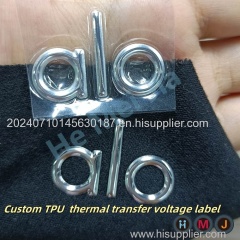
|
HMJ Silicone Garment Accessories Co., Ltd
|
3D effect high raised TPU heat transfer label#patch#tag#brand#sticker#badges#crest#logo#brand#trademark
| Payment Terms: | T/T,L/C,D/A,D/P,Paypal |
| Place of Origin: | Guangdong, China (Mainland) |
|
|
|
| Add to My Favorites | |
| HiSupplier Escrow |
Product Detail
3D effect high raised TPU heat transfer label#sewing label#brand#tag#patches#badges#trademarks#clohthing#garment#T-shirt#uniform#sportwear
Materials Needed
TPU Sheets: Thermoplastic polyurethane sheets that can be molded and shaped under heat.
Molds: Custom molds designed to create the 3D effect and raised details.
Laser Cutter or Engraver: For precise cutting and detailing.
Heat Press: For transferring the label onto the desired surface.
Adhesive Layer: To help bond the TPU to the fabric or material.
Protective Film: To protect the design during the heat transfer process.
Software: Use graphic design software to create a detailed design of your label. The design should consider the 3D effect, with varying heights and depths.
3D Modeling: If available, use 3D modeling software to visualize the raised effect and adjust the design accordingly.
Custom Molds: Depending on the complexity of your design, you may need custom molds. These can be created using CNC machining or 3D printing.
Mold Material: Ensure the mold material can withstand high temperatures and repeated use.
Laser Cutting: Use a laser cutter to cut the TPU sheet into the desired shape and size based on your design. Ensure precision to maintain the integrity of the design.
Engraving Details: If needed, use the laser engraver to add fine details to the TPU that will be highlighted in the 3D effect.
Heating the Mold: Preheat the mold to the necessary temperature for shaping the TPU.
Pressing: Place the TPU sheet into the mold and apply heat and pressure. The TPU will take on the shape of the mold, creating the raised, 3D effect.
Cooling: Allow the TPU to cool in the mold to set the shape.
Adhesive Layer: Apply a heat-activated adhesive layer to the back of the molded TPU label.
Protective Film: Place a protective film over the front of the label to protect the design during the heat transfer process.
Preheating: Preheat your heat press according to the TPU and adhesive manufacturer's instructions.
Positioning: Place the item to be labeled on the heat press, position the TPU label on it, and cover with a protective sheet if necessary.
Pressing: Apply the heat press with the appropriate temperature, pressure, and time settings. This usually involves temperatures around 300-350°F (150-177°C) and pressing for 10-15 seconds.
Cooling and Peeling: Allow the label to cool slightly before carefully peeling off the protective film.
Test Runs: Perform test runs to ensure the mold, heat, and pressure settings yield the desired 3D effect.
Clean Surfaces: Ensure both the TPU and the surface to be labeled are clean and free of debris for optimal adhesion.
Safety Precautions: Follow all safety guidelines for using molds, laser cutters, and heat presses.
Fashion and Apparel: Adds a premium, high-end look to clothing and accessories.
Sporting Goods: Durable and resistant to wear and tear, suitable for sports gear.
Branding and Promotional Items: Eye-catching and tactile, ideal for branding purposes.
Steps
1. Design Creation
2. Creating the Mold
3. Cutting and Shaping the TPU
4. Molding the TPU
5. Preparing for Heat Transfer
6. Heat Pressing
Tips for Success
Applications













